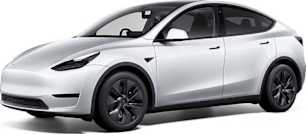This is one of the areas that Rivian has excelled at and it makes the R1T a real standout in its class. Because it's a bespoke design there are a number of clever practical features around the cabin.
Starting with the Bluetooth speaker that slides out of the centre console. So you can play your music through the car's speakers or, when you leave the car, take your tunes with you. The sound system is another in-house Rivian set-up, like the multimedia, with the company splitting with original partner, audio specialist, Meridian.
Other clever interior touches include the charging pad (complete with tiny Rivian logo pattern), a sizable centre console box and a torch recessed in the door. There are also a power outlets in the cabin, rather than just USB ports, so you can charge your electronics on the move.
Rivian has also developed a 'Pet Mode' for the cabin, which the company claims allows owners to safely leave their pets in the car. The system allows the air-conditioning to keep running, even while the ignition is off, so your pet doesn't get overheated or freeze, and the media screen displays a message saying that your pet is okay (so no good Samaritan smashes your window to save your animal friend).
The R1T's other major party trick is the 'cargo tunnel' that runs the width of the car, taking advantage of the empty space between the cabin and the tray. This is a unique feature for the R1T, allowing for an extra 331 litres of lockable storage, which can be accessed on both sides or through the cabin via the rear seats.
Rivian even showed off a 'Camp Kitchen' that could slide in and out of the tunnel. This elaborate accessory was designed to make camping easier, featuring an induction cooktop, sink and crockery, but it has since been removed from the company's website as it is reportedly redesigned. Hopefully it's available again by the time the R1T makes it to Australia.
This would work in tandem with the 'Camp Mode' function that lets the ute self-level its suspension so the body is flat on uneven ground and turns off the exterior lights and sounds not to distract others, while still allowing you to use the power outlets in the tray and cargo tunnel.
As for the space in the cabin, it's good in the front and rear. With a 3449mm wheelbase there's generous room for the rear occupants that allows for two adults to sit in comfort, and Rivian claims it's wide enough for three child seats.
As for storage, in addition to the cargo tunnel, there's under bonnet storage measuring 314 litres, so there's plenty of out-of-sight space despite it being a ute.
The tray measures quite square, at 1374mm long and 1297mm wide, but Rivian has designed the tailgate to sit flush with the tray bed, which can extend the usable length to 2131mm.
The tray itself has several handy features. These include multiple power outlets and an air-compressor, so you can add extra pressure to your tyres if you let them down to go off-roading or pump up camping equipment.
Underneath the tray is the housing to keep the spare tyre on the off-road package, but as a spare isn't available on all models as standard, it can be used as storage for wet or dirty items because it's washable and has a drainage hole.

















